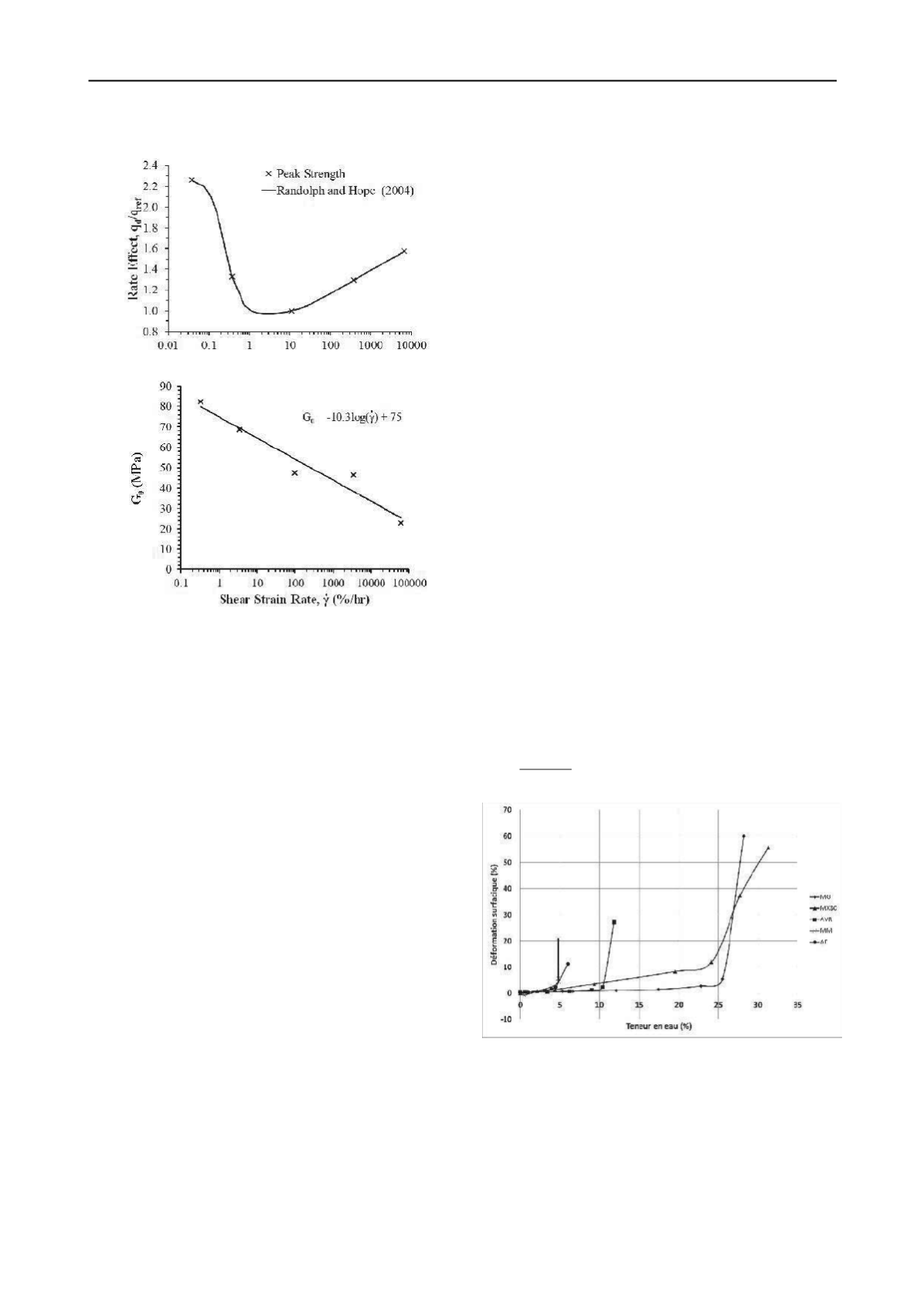
193
Technical Committee 101 - Session I /
Comité technique 101 - Session I
Proceedings of the 18
th
International Conference on Soil Mechanics and Geotechnical Engineering, Paris 2013
Figure 5. Top: Rate effect against normalised velocity at peak strength
experimental data and model by Randolph and Hope (2004) using a
shear strain rate of 100%/hr as the reference rate; bottom: variation of
G
0
against shear strain rate (Robinson and Brown 2013).
Characterisation in one-dimensional loading and undrained
triaxial compression of a bentonite mixed with different
amounts of silicon sand performed by Yin and Tong (2013)
showed creep, swelling and strain rates effects dependent on the
amount of sand. Zhakulin et al. (2013) present results of long-
term observations (over 50 years) of settlements of some
industrial structures in Kazakhstan founded in clayey soils.
Laboratory investigation of the volumetric creep behaviour of
the clayey soils is also studied in laboratory on undisturbed
samples. Interestingly, it is also shown that the settlements
calculated by two different design methods are much higher
than the settlements experienced by the real structures.
The settlement behaviour of clay soils, including the effects
of time and timescale effects between a thin laboratory
specimen and a thick in situ soil layer is not a new research
topic, yet still very open as the interpretation of different results
remains controversial and does not appear to converge towards
a clear and unique framework. The work of Degago et al.
(2013) goes at the heart of these controversies by analyzing the
validity of creep hypothesis A in open conflict with creep
hypothesis B (as previously defined by Ladd et al. 1977).
Based on a critical review of relevant experimental
investigations from the literature, the main misconceptions
around the hypothesis A are discussed and detailed
argumentation is advanced. It is also emphasized that the creep
hypothesis B agrees well with the measured behaviour of
cohesive soils, the experimental results can be consistently
explained using a model based on the isotache concept.
The performance of one-dimensional (1D) formulations of
two elasto-viscoplastic models for normally consolidated clays,
one based on non-stationary flow surface type (Sekiguchi 1977)
and the other one over-stress type (Perzna 1963) is assessed
Nakai et al. (2013) against a new model that describes the time-
dependency based on the normal consolidation line (NCL) on
e
–
ln
plane strain rate dependent shift and using the subloading
surface concept by Hashiguchi (1980). The new model is
extended for over-consolidated clay cases, by introducing a new
state parameter - the difference between the current void ratio
and the void ratio on the NCL. The introduction in the model of
another state variable, linked to an imaginary increase of density
due to bonding effect, successfully captures the response of
structured clays as well.
3 EXPANSIVE SOILS
Expansive soils are soils that undergo significant volume
change associated with variations in water content. These
volume changes can either be in the form of swell or in the form
shrinkage and they are derived from clay minerals that undergo
hydration due to rainfall and dehydration due to evaporation.
However, water access to individual clay particles depends on,
and The shrink-swell potential of expansive soils is determined
by the soil state (void ratio, the initial water content), internal
structure (micropores within soil peds and macropores between
the soil peds), vertical stresses, as well as the type and amount
of clay minerals like smectite, montmorillonite, nontronite,
vermiculite, illite, and chlorite in the soil (Jones and Jefferson
2012).
Maison et al. (2013) present a new experimental device
incorporated into an Environmental Scanning Electron
Microscope (ESEM). This new apparatus allows the
simultaneous measurements of both surface area of clay
minerals and water content evolution. The latter is deduced
from the sample weighting, while the former is based on the
image analysis technique. A complete wetting-dry cycle can be
performed in less than 24 hours, faster than the classic tests on
representative soil element samples. Figure 6 shows the
evolution of the surface strain,
s
, with the moisture content for
several homogenous and heterogeneous natural clays.
s
represents the relative change of the surface area S
i
of the clay
minerals at time t
i
in respect with the initial area S
o
:
(2)
Figure 6. Variation of the surface strain with moisture content measured
with the new experimental device developed by Maison et al. (2013).
Internal structure evolution of undisturbed and remoulded
expansive soils during triaxial loading conditions and with the
application of several wet-dry cycles is studied by Chen (2013)
on a CT scanning device. Both loading conditions accelerate the
development of the initial structural cracks and fissures (Figure
7). The process of shrinkage causes structural cracks, which on
re-wetting, do not close-up and facilitates the access of the
water.
Normalised Velocity, V
o
o
i
s
S
S S


